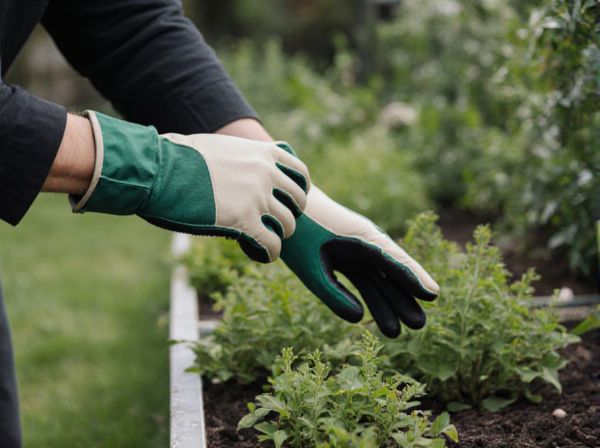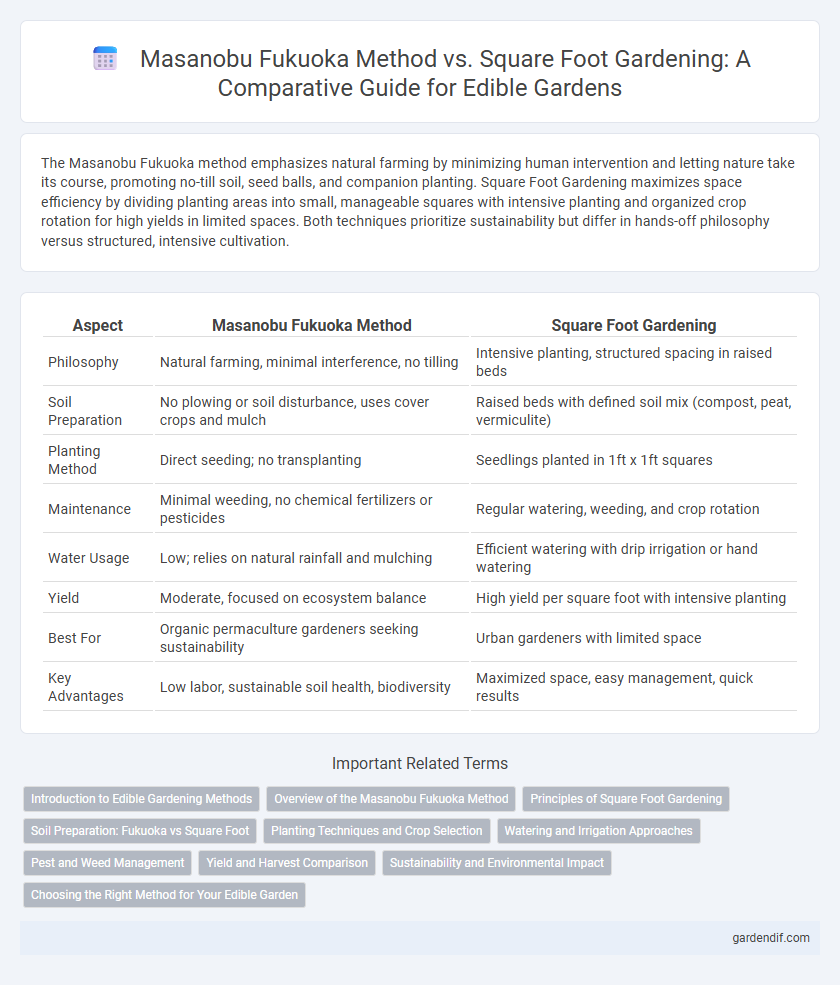
Masanobu Fukuoka Method vs Square Foot Gardening Illustration
The Masanobu Fukuoka method emphasizes natural farming by minimizing human intervention and letting nature take its course, promoting no-till soil, seed balls, and companion planting. Square Foot Gardening maximizes space efficiency by dividing planting areas into small, manageable squares with intensive planting and organized crop rotation for high yields in limited spaces. Both techniques prioritize sustainability but differ in hands-off philosophy versus structured, intensive cultivation.
Table of Comparison
| Aspect | Masanobu Fukuoka Method | Square Foot Gardening |
|---|---|---|
| Philosophy | Natural farming, minimal interference, no tilling | Intensive planting, structured spacing in raised beds |
| Soil Preparation | No plowing or soil disturbance, uses cover crops and mulch | Raised beds with defined soil mix (compost, peat, vermiculite) |
| Planting Method | Direct seeding; no transplanting | Seedlings planted in 1ft x 1ft squares |
| Maintenance | Minimal weeding, no chemical fertilizers or pesticides | Regular watering, weeding, and crop rotation |
| Water Usage | Low; relies on natural rainfall and mulching | Efficient watering with drip irrigation or hand watering |
| Yield | Moderate, focused on ecosystem balance | High yield per square foot with intensive planting |
| Best For | Organic permaculture gardeners seeking sustainability | Urban gardeners with limited space |
| Key Advantages | Low labor, sustainable soil health, biodiversity | Maximized space, easy management, quick results |
Introduction to Edible Gardening Methods
Masanobu Fukuoka's method emphasizes natural farming principles, promoting minimal soil disturbance and no chemical inputs to foster self-sustaining ecosystems in edible gardening. Square Foot Gardening optimizes space by dividing growing areas into precise one-foot sections, enhancing yield efficiency and ease of maintenance. Both techniques prioritize sustainability and resourcefulness but differ in approach--Fukuoka's method aligns with permaculture ethics, while Square Foot Gardening suits urban and small-scale gardeners seeking structured planting.
Overview of the Masanobu Fukuoka Method
The Masanobu Fukuoka Method emphasizes natural farming by minimizing soil disturbance, avoiding chemical inputs, and promoting biodiversity through minimal intervention and no-tillage practices. This technique utilizes a cover crop and seed balls to enhance soil fertility and encourage natural seed dispersal, fostering a self-sustaining ecosystem. Compared to Square Foot Gardening, which relies on structured planting grids and intensive soil preparation, the Fukuoka Method prioritizes ecological harmony and soil health over controlled planting patterns.
Principles of Square Foot Gardening
Square Foot Gardening maximizes space efficiency by dividing the garden into small, manageable sections, each one square foot in size, allowing for intensive planting and higher yields. This method emphasizes soil health through the use of a balanced soil mix called Mel's Mix, composed of compost, peat moss, and vermiculite, which enhances nutrient retention and moisture control. Unlike Masanobu Fukuoka's natural farming, Square Foot Gardening relies on structured planning and regular maintenance to optimize growth and minimize weed presence.
Soil Preparation: Fukuoka vs Square Foot
The Masanobu Fukuoka method emphasizes minimal soil disturbance, relying on natural processes like cover cropping and mulching to enrich soil health without tilling. Square Foot Gardening uses raised beds filled with a precise soil mix--typically equal parts compost, peat moss, and vermiculite--to optimize nutrient availability and drainage. While Fukuoka's approach promotes sustainable, no-till soil regeneration, Square Foot Gardening focuses on controlled, nutrient-rich soil environments for intensive planting.
Planting Techniques and Crop Selection
Masanobu Fukuoka's method emphasizes natural farming principles, favoring minimal soil disturbance and reliance on cover crops and seed balls for planting, which encourages biodiversity and soil health. Square Foot Gardening divides planting areas into precise, manageable sections, optimizing space with intensive planting and tailored crop rotation to maximize yield per square foot. While Fukuoka's approach supports perennial and self-sustaining crops, Square Foot Gardening prioritizes high-value short-term vegetables and herbs through organized, grid-based planting systems.
Watering and Irrigation Approaches
The Masanobu Fukuoka method relies on minimal irrigation, emphasizing natural rainfall and maintaining soil moisture through heavy mulching and ground cover to reduce water evaporation. In contrast, Square Foot Gardening employs targeted, efficient watering techniques such as drip irrigation or soaker hoses within compact, raised beds that conserve water and direct it precisely to plant roots. Both methods optimize water use, but Fukuoka's approach integrates natural ecosystem cycles, while Square Foot Gardening leverages controlled irrigation technology for maximum water efficiency.
Pest and Weed Management
The Masanobu Fukuoka Method emphasizes natural pest and weed management through no-till farming, using cover crops and mulching to suppress weeds and create a balanced ecosystem that deters pests. Square Foot Gardening relies on dense planting and physical barriers like row covers and hand-weeding to control pests and minimize weed growth efficiently within small plots. Both methods prioritize minimizing chemical interventions, but Fukuoka's approach fosters long-term soil health while Square Foot Gardening offers immediate pest and weed control in limited spaces.
Yield and Harvest Comparison
The Masanobu Fukuoka Method emphasizes natural, no-till farming that promotes soil health, resulting in steady but moderate yields ideal for perennial crops and grains. Square Foot Gardening optimizes space with intensive planting, producing higher yields per square foot for vegetables in shorter harvest cycles. Gardeners seeking maximum vegetable production in limited space often prefer Square Foot Gardening, while those valuing sustainability and less labor favor the Fukuoka Method for balanced long-term yields.
Sustainability and Environmental Impact
The Masanobu Fukuoka method emphasizes natural farming techniques that avoid synthetic chemicals and minimize soil disturbance, promoting ecosystem balance and biodiversity. Square Foot Gardening maximizes space efficiency and reduces water usage through intensive planting in small, structured beds, decreasing resource waste. Both methods enhance sustainability by reducing environmental impact, with Fukuoka's approach fostering long-term soil fertility and Square Foot Gardening optimizing resource use in urban settings.
Choosing the Right Method for Your Edible Garden
Choosing the right edible garden method depends on available space, maintenance preference, and crop variety; Masanobu Fukuoka's natural farming emphasizes minimal intervention and soil health, ideal for sustainable, low-effort gardens with diverse plants. Square Foot Gardening maximizes productivity in small spaces using raised beds and intensive planting, perfect for gardeners seeking organized, high-yield vegetable plots. Assessing factors like soil conditions, time commitment, and desired harvest can guide optimal method selection for a thriving edible garden.
Masanobu Fukuoka Method vs Square Foot Gardening Infographic

 gardendif.com
gardendif.com